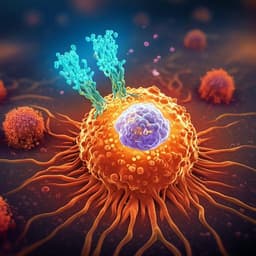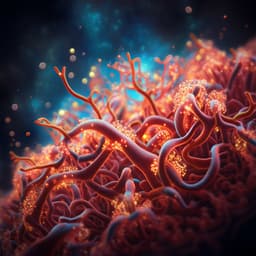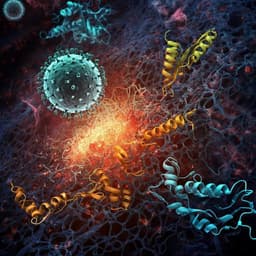
Chemistry
Engineering transient dynamics of artificial cells by stochastic distribution of enzymes
S. Song, A. F. Mason, et al.
This groundbreaking research introduces an innovative artificial platform that utilizes stochasticity to control the motility of artificial cells. By confining enzymes to fluidic polymer membranes, the study reveals how asymmetric distribution of propulsive units enhances motility in the presence of substrates, paving the way for synthetic systems mimicking life-like behaviors. This work was carried out by Shidong Song, Alexander F. Mason, Richard A. J. Post, Marco De Corato, Rafael Mestre, N. Amy Yewdall, Shoupeng Cao, Remco W. van der Hofstad, Samuel Sanchez, Loai K. E. A. Abdelmohsen, and Jan C. M. van Hest.
~3 min • Beginner • English
Introduction
The study addresses how stochastic events—ubiquitous in biological processes—can be actively harnessed as a design element in synthetic systems to produce adaptive, life-like behaviors. While stochasticity has been acknowledged to influence micromotor behavior (e.g., random surface positioning of catalysts), it has not been purposefully introduced to control system features. The authors propose a micromotor based on coacervate microdroplets cloaked with a fluidic polymer membrane bearing enzymes as propulsive units. Contrary to expectations of monotonic motility increase with enzyme density, initial observations motivated the development of a physical model and in silico analysis. The central hypothesis is that a transient, stochastically arising asymmetry in enzyme distribution on a fluidic membrane can generate net propulsion, and that understanding this stochasticity allows modulation of motile behavior.
Literature Review
Prior work emphasized structural asymmetry (shape, Janus catalyst distribution) as necessary for autonomous motion, including Janus particles with hemispherical catalysts and Marangoni-flow-driven droplets enabling autonomous and collective motion and navigation. Recent studies showed that random enzyme distributions on rigid nanoparticles or fluid liposomes can propel micromotors in fuel. However, these systems rely on static or externally fixed asymmetries rather than exploiting dynamic, transient asymmetry. The present work extends this by enabling spatiotemporal stochastic enzyme distribution via a fluidic polymer membrane on coacervates, allowing dynamic asymmetry analogous to natural systems. References include enzyme-powered micromotors with stochastic surface distribution (Patiño et al., Ghosh et al.), phoretic swimmer design and behavior (Golestanian et al., Illien et al.), and Janus particle motility (Howse et al.).
Methodology
- Platform construction: Complex coacervate droplets formed by coacervation of oppositely charged polyelectrolytes and stabilized by a fluidic polymer membrane. The membrane includes an azide-functionalized polymer (α-azido-PEG-b-(ε-caprolactone-gradient-trimethylene carbonate)) blended with a block terpolymer, enabling strain-promoted alkyne-azide cycloaddition (SPAAC) with DBCO-modified enzymes.
- Enzyme functionalization and attachment: Catalase (CAT) and urease (UR) were modified with DBCO (mCAT, mUR) and covalently tethered to the membrane (confirmed by Cy5 fluorescence confocal imaging showing ring-like distribution).
- Membrane fluidity and enzyme mobility: Fluorescence recovery after photobleaching (FRAP) on Cy5-labeled mCAT and mUR measured lateral diffusivity of surface-tethered enzymes; mCAT D_l ≈ 0.035 µm²/s, mUR D_l ≈ 0.030 µm²/s. Time-lapse confocal imaging showed dynamic clustering and punctate radial intensity, indicating transient asymmetry.
- Motility assays: Bright-field microscopy at 25 fps for 30–35 s recorded trajectories of 15–20 coacervates per condition. Conditions included presence/absence of fuel (mCAT: 10 mM H2O2; mUR: 500 mM urea). Custom Python script extracted X–Y trajectories, computed mean square displacement (MSD), and velocities.
- Enzyme density manipulation and quantification: Fabricated low, medium, and high surface enzyme densities (exact numbers in Supplementary Tables). Density quantified via counting coacervates per sample volume, total attached enzyme via Cy5 fluorescence of pellet vs supernatant after centrifugation.
- Substrate depletion assessment: Estimated Damköhler number Da = r R / (D C_bulk) with r = k_cat Γ and Γ estimated at maximum packing (Γ ≈ 0.91/(π r_enz^2)). Calculated Da for mCAT (~0.13) and mUR (~4.5×10^−4), both < 1, indicating diffusion-limited substrate supply and negligible local depletion.
- Stochastic modeling: Developed a stochastic mechanical model modifying the active Brownian particle (ABP) framework to include lateral enzyme diffusion and fluctuating dipole orientation. Assumed propulsion along the dipole of surface enzyme distribution with velocity proportional to its magnitude. Derived MSD(Δt) expression incorporating translational diffusion D_t, rotational diffusion, enzyme lateral diffusivity D_l, number of enzymes A, and expected velocity V.
- Simulations: Implemented spherical Brownian motion (SBM) for enzyme lateral diffusion on a sphere (D_l), SBM for coacervate rotational diffusion (D_r), and 3D Brownian motion for translational diffusion (D_t). Simulated varying enzyme densities and diffusivities; fitted model to experimental MSD to estimate parameters (D_l and V). Stochastic simulation code available on GitHub.
- Tuning enzyme diffusivity: Chemically crosslinked surface-bound catalase with glutaraldehyde to reduce D_l. Verified reduced recovery via FRAP (minimal recovery over >100 s). Chose larger coacervates (diameter ~3.6 µm) to emphasize ballistic regime (τ* >> Δt) and assess motility changes upon crosslinking.
- Data analysis: Computed MSD curves, velocities, and assessed ballistic-to-diffusive crossover; evaluated trajectory expansion with fuel and under crosslinking.
Key Findings
- Dynamic transient asymmetry: Surface-tethered enzymes on fluidic polymer membranes display dynamic clustering and heterogeneous distribution over time, evidenced by punctate confocal intensity patterns and FRAP-measured lateral diffusivities (mCAT D_l ≈ 0.035 µm²/s; mUR D_l ≈ 0.030 µm²/s).
- Fuel-dependent propulsion: In absence of fuel, coacervates exhibit Brownian motion; with fuel (mCAT: 10 mM H2O2; mUR: 500 mM urea), MSDs increase significantly and trajectories expand, indicating self-propulsion.
- Non-monotonic enzyme density effect: Across low, medium, and high densities (diameter ~1.2 µm), medium density yields the highest MSDs and velocities for both mCAT and mUR. High density behaves similarly to low density, contradicting monotonic expectations. Damköhler numbers (mCAT ~0.13; mUR ~4.5×10^−4) indicate no substrate depletion, supporting a stochastic asymmetry mechanism.
- Mechanistic explanation: Maximal propulsion arises from a balance between probability of transient asymmetry (higher at low density) and the number of propulsive units (higher at high density). Medium density optimizes this trade-off. A probability density analysis of asymmetry vs enzyme number supports this nonlinearity.
- Stochastic model and analytical MSD: Derived MSD(Δt) predicts ballistic motion at short times and diffusive at long times, with a crossover governed by enzyme lateral diffusivity and rotational diffusion. Model incorporates enzyme mobility absent from standard ABP.
- Simulation agreement: Stochastic simulations (SBM-based) reproduce experimental MSDs and the non-monotonic density relationship when incorporating density-dependent expected velocities. Simulated MSDs agree with analytical expression and experiments.
- Tuning diffusivity enhances propulsion: Reducing enzyme lateral diffusivity via glutaraldehyde crosslinking increases MSDs and velocities for mCAT-functionalized coacervates (diameter ~3.6 µm), consistent with simulations predicting higher propulsion for lower D_l. FRAP confirms reduced recovery post-crosslinking.
- Additional phenomenon: Approximately 10% of non-crosslinked mCAT-coacervates exhibit bacterial-like run-and-tumble motion with instantaneous velocities during runs exceeding model predictions, potentially due to stochastic oxygen microbubble release.
- Quantitative details: Typical sample sizes n ≈ 17–18 per condition; imaging at 25 fps for ~30–35 s; enzyme coverages up to ~87% (Supplementary); observed ballistic-to-diffusive crossover in MSD; no local substrate depletion due to Da < 1.
Discussion
The findings validate the hypothesis that stochastic, transient asymmetry in enzyme distribution on a fluidic membrane can drive autonomous motility in artificial cells. By integrating enzyme lateral diffusivity and rotational diffusion into a modified ABP framework, the study shows that motility arises from and can be controlled by stochastic processes rather than fixed structural asymmetry. The non-monotonic dependence of motility on enzyme density underscores the nonlinear interplay between transient asymmetry probability and the number of propulsive units. Importantly, enzyme lateral diffusivity serves as a tunable lever to adjust the lifetime of asymmetry, enabling modulation of the ballistic-to-diffusive transition and overall propulsion. The close agreement between theory, simulation, and experiment demonstrates predictive control, advancing the design of active matter systems. The observed run-and-tumble outliers suggest additional stochastic mechanisms (e.g., bubble dynamics) can produce more complex behaviors not captured by the current model, hinting at rich design space for future adaptive systems.
Conclusion
This work introduces and validates a design philosophy that leverages stochasticity—via dynamic, transient asymmetry of membrane-tethered enzymes—to engineer motility in artificial cells. The authors construct coacervate-based micromotors with fluidic polymer membranes, demonstrate fuel-dependent propulsion without fixed asymmetry, uncover a non-monotonic relationship between enzyme density and motility, and develop a stochastic model and simulations that accurately predict observed dynamics. By experimentally tuning enzyme lateral diffusivity through crosslinking, they enhance propulsion in line with theoretical predictions, showcasing control over stochastic mechanisms. Future research directions include exploring stochasticity-enabled behaviors such as chemotaxis, extending models to capture run-and-tumble dynamics and bubble effects, and applying these principles to other adaptive synthetic systems.
Limitations
- The stochastic model, while predictive for most behaviors, does not capture the observed run-and-tumble motions found in ~10% of catalase-functionalized coacervates; simulations could not reproduce this behavior, likely due to unmodeled effects such as stochastic oxygen microbubble release.
- The non-monotonic density–motility relationship required incorporating density-dependent expected velocities in simulations, indicating incomplete mechanistic understanding at the single-enzyme propulsion level.
- Findings are demonstrated for specific enzymes (catalase, urease) and a particular polymer membrane/coacervate system; generalizability to other enzymes and membrane chemistries requires further validation.
- Quantitative parameters (e.g., enzyme numbers, coverages) rely on fluorescence-based estimates and assumptions (e.g., maximum packing for Damköhler estimates), which may introduce uncertainties.
Related Publications
Explore these studies to deepen your understanding of the subject.







